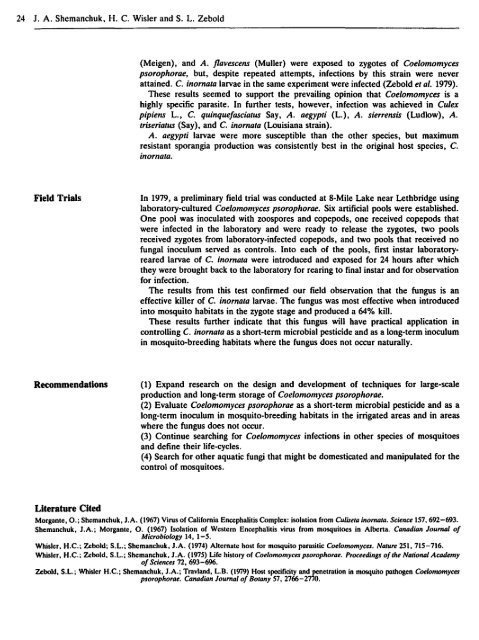pdf, 57.71Mb - Entomological Society of Canada
pdf, 57.71Mb - Entomological Society of Canada
pdf, 57.71Mb - Entomological Society of Canada
You also want an ePaper? Increase the reach of your titles
YUMPU automatically turns print PDFs into web optimized ePapers that Google loves.
24 J. A. Shemanchuk. H. C. Wisler and S. L. Zebold<br />
Field Trials<br />
Recommendations<br />
Literature Cited<br />
(Meigen), and A. flavescens (Muller) were exposed to zygotes <strong>of</strong> Coelomomyces<br />
psorophorae, but, despite repeated attempts, infections by this strain were never<br />
attained. C. inornata larvae in the same experiment were infected (Zebold et al. 1979).<br />
These results seemed to support the prevailing opinion that Coelomomyces is a<br />
highly specific parasite. In further tests, however, infection was achieved in Culex<br />
pipiens L., C. quinquefasciatus Say, A. aegypti (L.), A. sierrensis (Ludlow), A.<br />
triseriatus (Say), and C. inornata (Louisiana strain).<br />
A. aegypti larvae were more susceptible than the other species, but maximum<br />
resistant sporangia production was consistently best in the original host species, C.<br />
inornata.<br />
In 1979, a preliminary field trial was conducted at 8-Mile Lake near Lethbridge using<br />
laboratory-cultured Coelomomyces psorophorae. Six artificial pools were established.<br />
One pool was inoculated with zoospores and copepods, one received copepods that<br />
were infected in the laboratory and were ready to release the zygotes, two pools<br />
received zygotes from laboratory-infected copepods, and two pools that received no<br />
fungal inoculum served as controls. Into each <strong>of</strong> the pools, first instar laboratoryreared<br />
larvae <strong>of</strong> C. inornata were introduced and exposed for 24 hours after which<br />
they were brought back to the laboratory for rearing to final instar and for observation<br />
for infection.<br />
The results from this test confirmed our field observation that the fungus is an<br />
effective killer <strong>of</strong> C. inomata larvae. The fungus was most effective when introduced<br />
into mosquito habitats in the zygote stage and produced a 64% kill.<br />
These results further indicate that this fungus will have practical application in<br />
controlling C. inornata as a short-term microbial pesticide and as a long-term inoculum<br />
in mosquito-breeding habitats where the fungus does not occur naturally.<br />
(1) Expand research on the design and development <strong>of</strong> techniques for large-scale<br />
production and long-term storage <strong>of</strong> Coelomomyces psorophorae.<br />
(2) Evaluate Coelomomyces psorophorae as a short-term microbial pesticide and as a<br />
long-term inoculum in mosquito-breeding habitats in the irrigated areas and in areas<br />
where the fungus does not occur.<br />
(3) Continue searching for Coelomomyces infections in other species <strong>of</strong> mosquitoes<br />
and define their life-cycles.<br />
(4) Search for other aquatic fungi that might be domesticated and manipulated for the<br />
control <strong>of</strong> mosquitoes.<br />
Morgante. 0.; Shemanchuk. J.A. (1967) Virus <strong>of</strong> California Encephalitis Complex; isolation from Cuiisela inornata. Science 157. 692-693.<br />
Shemanchuk. J.A.; Morgante. O. (1967) Isolation <strong>of</strong> Western Encephalitis virus from mosquitoes in Albena. Canadian JoumJll <strong>of</strong><br />
Microbiology 14.1-5.<br />
Whisler. H.C.; Zebold; S.L.; Shemanchuk. J.A. (1974) Alternate host for mosquito parasitic Coelomomyces. Nature 251. 715-716.<br />
Whisler. H.C.; Zebold. S.L.; Shemanchuk. J.A. (1975) Life history <strong>of</strong> Coelomomyces psorophorae. Proceedings <strong>of</strong> the National Academy<br />
<strong>of</strong> Sciences 72. 693-696.<br />
Zcbold. S.L.; Whisler H.C.; Shemanchuk. J.A.; Travland. L.B. (1979) Host specilicity and penetration in mosquito pathogen Coe/omomyces<br />
psorophorae. Canadian Journal <strong>of</strong> Botany 57. 2766-2nO.
















